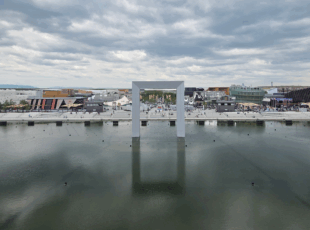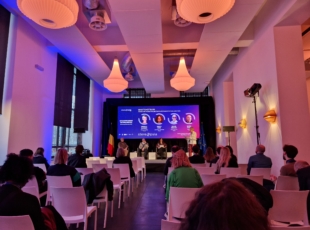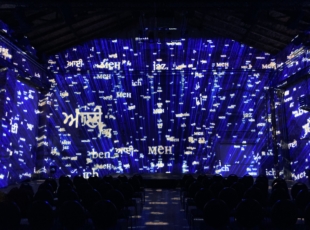Environmentalism v. Digital: finding the balance between paradoxical dictates

Article author :
IMPACT in Liège brought together some 250 international professions on November 1-4 on the occasion of the Impact Forum. Days punctuated by pitches, performances and round tables. One of them – titled ‘Environmentalism and the Digital, lost in transition?’ and organised by the French embassy in Belgium* – allowed 4 European and Asian actors within the domain of the performing arts to discuss the issues of the green and digital transitions within culture. Often convergent, the viewpoints of the guests demonstrate the extent to which the ‘transitions’ debate must be taken to the collective level.
This article is a republication. The original was published on HACNUMedia (the media that explores the connections between technology and creativity), a partner of kingkong.
The imperative of the digital transition…
‘The latest data from the Ministry of Culture in France indicate that 15% of the French population have cultural practices which are exclusively digital’ (Editor’s note: Cultural practices inquiry, DEPS, 2018), by way of introduction states Anne Le Gall, the general delegate of TMNlab / Theatres and Digital Mediation Laboratory. ‘This involves the consumption of online content but also of creative practices, of networked games. That means that when you lead a mission to diversify the audiences of a cultural project, you have to ask yourself a key question: how to reach out to these audiences, whose numbers will only rise in the coming years.’ A reminder which avoids slipping into a knee-jerk condemnation of technologies. While today the discoverability of cultural content is linked to algorithmic mechanisms and filter bubbles, professionals need to be aware of the digital issues and the real impact of the tools to make the best-informed choices possible. ‘It’s a question of positioning yourself alongside the uses, both of the artists and of the audiences – also as a means of evaluating the diversity of uses, the creativity, the forms of digital cultures,’ adds Anne Le Gall. An assessment shared by Kyu Choi, the artistic director of the Seoul Performing Arts Festival (SPAF). ‘The pandemic marked a major turning-point in the use of technologies and transformed them extensively. The digital transition has impacted our daily lives, in such a way that contemporary audiences and artists have not been able to stand firm against it.’
… and that of the green transition
For all that, Sasapin Siriwanij, the artistic director of the Bangkok International Performing Arts Meeting (BIPAM), rejects any zealotry. ‘The first question which must be asked, is the context and the usefulness of the digital. Does a creation necessarily need digital technologies? If the digital does not provide particular insight, it becomes incidental.’ Incidental is putting it mildly in a world in which are tallied around 3.5 billion smartphones, 1.1 billion DSL (or fibre) boxes or 10 million 2G to 5G cell towers (source Green It). Worse still, around 3.8% of the greenhouse gases (GHG) worldwide are directly attributable to the digital domain, whilst estimates for 2040 put this figure at around 10%. A percentage which it is impossible to genuinely assess, at a time when the digital – with GenAI at the forefront – is undergoing exponential growth. An enlightened green transition is becoming even more complex for the actors in the culture domain when the subject is analysed beyond GHG indicators. ‘We talk a lot about GHG, but there are other impacts to be assessed. The consumption of water and electricity, both for manufacturing and to support the uses, the extraction of rare earths, the impact on biodiversity … The social aspect as well, the impact on work – from the GIG economy to click workers – and the digital divides,’ adds Anne Le Gall. A comment which directly echoes the 9 planetary limits definitively widening the debate. Jérôme Villeneuve, Director of the Théâtre Hexagone Scène Nationale in Meylan, sums up the dilemma facing cultural bodies and artists. ‘Whether it is the GHG with the pathways dictated by the Paris Agreement or the depletion of abiotic resources, the scenarios are not sustainable. For us, cultural actors, there are no obvious solutions.’

Experiment, share and decentre your viewpoint
That has not prevented festivals from experimenting with new practices. Regarding the BIPAM, ‘we have developed a project called the Climate Dramaturgy Lab. It is a pioneering initiative aiming to swap ideas within the Thailand and British theatre community,’ explains Sasapin Siriwanij. In concrete terms, over a five-day period, the workshop brings together a group of theatre professionals, including scriptwriters, costume designers, performers, directors, producers, university lecturers and other theatre enthusiasts on the subject of environmental themes. A prime example of the need to work the question of the green and digital transitions at sector level and during each stage of a creation. As far as the SPAF is concerned, the team is working on the Next Mobility project, a programme around art-project related travel, considered to be one of the key items in a work’s carbon inventory (cf. Case Study for Responsible Immersiveness). ‘Next Mobility explores what the exchange and mobility of the performing arts would look like in the pandemic/post-pandemic era. It focuses on certain trends such as digitization, hybrid exchange and green mobility which have influenced the creation and distribution of performances,’ explains Kyu Choi, before adding: ‘What do we want to tell people through international mobility? What needs mobility and why?’
A question far from being rhetorical, given the extent to which mobility meets different objectives and contexts. ‘Europe and Asia have different contexts. For example, in Asia, the railway transport offer is practically non-existent, and mobility is occasionally one of the sole levers to make culture happen. Mobility matches up with objectives of openness, even democracy, for actors who are isolated on the national and international scene,’ Sasapin Siriwanij quite rightly reminds us. Here again, cross-border cooperation and a roadmap on an international scale appear to be issues requiring priority attention.

Shaping new imaginaries
A need all the more obvious in that the green and digital transitions do not solely involve renewed professional practices, but also the perspectives on society offered by the artists or by the sensitive experiences which we, the citizens, make through their works. ‘Many digital artists are critical as regards the uses made of digital tools. We are a long way from the ideologies of the mainstream platforms … The artists raise questions about environmental impact, inclusion, law, sovereignty, identity. The digital is often tool, object and subject. It is vital to have these reflections to consider other futures,’ comments Anne Le Gall. The work of the artists also invites a questioning of the Anthropocene and our relationship with the living world. The notion of the ecosophy, a theory in which human beings are not at the top of the hierarchy of living beings is genuinely explored through numerous artistic creations.
The assessment for Jérôme Villeneuve includes a slight nuance: ‘if culture has a transformational power, it must not avoid a deep-seated green transition. And from this perspective the digital is not the sole vector to think through the world afterwards. It‘s obvious but too often forgotten.’ At the Hexagone Theatre, culture therefore encounters various science domains – the environment, sociology – precisely to sidestep a digital realm evoked too often.

Structuring an environmentally responsible digital ecosystem
So, what room for manoeuvre is there for culture professionals struggling to find a right balance between green and digital transition? First of all, define your position on an individual level: ‘you have to find your own alignment, do your own arbitration, by oneself or within workplace collectives,’ summarises Anne Le Gall. Then, in order to avoid being paralysed by all these paradoxical dictates, the collective momentum, at activity sector level, would appear to be an appropriate solution. Here there are a good number of levers: first of all, maintaining discussion forums, interactions between networks and professionals, just like the mission taken on board by the Impact Forum. Next, get yourself heard by political decision makers to have the existing frames of reference reassessed. This also applies to eco-conditionality as well as impact indicators intrinsic to culture. ‘The markers of artistic projects, the specifications, lean on rationales of profitability, increase, growth. The references need to be reevaluated. At sector level there is also the question of a regime change which may potentially be raised,’ analyses Jérôme Villeneuve.
The structuring of digital equipment sectors is also a major focal point: in other words, extending products’ lifespans, encouraging reuse, including the pooling of equipment, organising recycling channels (a reduce/reuse/recycle approach already being implemented in the area of the social economy and solidarity). Finally, the issue of training is obviously a leading collective issue. The TMNlab has, as it happens, published, in consortium with HACNUM (the national network for hybrid arts and digital cultures), a diagnosis on this question. ‘The future Skills & Professions diagnosis enables us to understand the digital transformations in culture. It is that which allows us to identify the issues of the way professions are evolving. The aim is to define the key training focal points and to distinguish transformation practices to provide support for artistic creation in the digital era in an age of transitions, in particular amongst learning communities,’ clarifies Anne Le Gall. Obviously, these actions as a whole will not solve the environmental crisis. But they will at least cast a little light where many professionals are still ‘lost in transition’.
* On the occasion of IMPACT, the French Embassy in Belgium arranged the travel for a delegation consisting of some twenty or so performing arts professionals who are members of French networks (TRAS, HACNUM, TMNlab) and also oversaw this round table.
A story, projects or an idea to share?
Suggest your content on kingkong.





